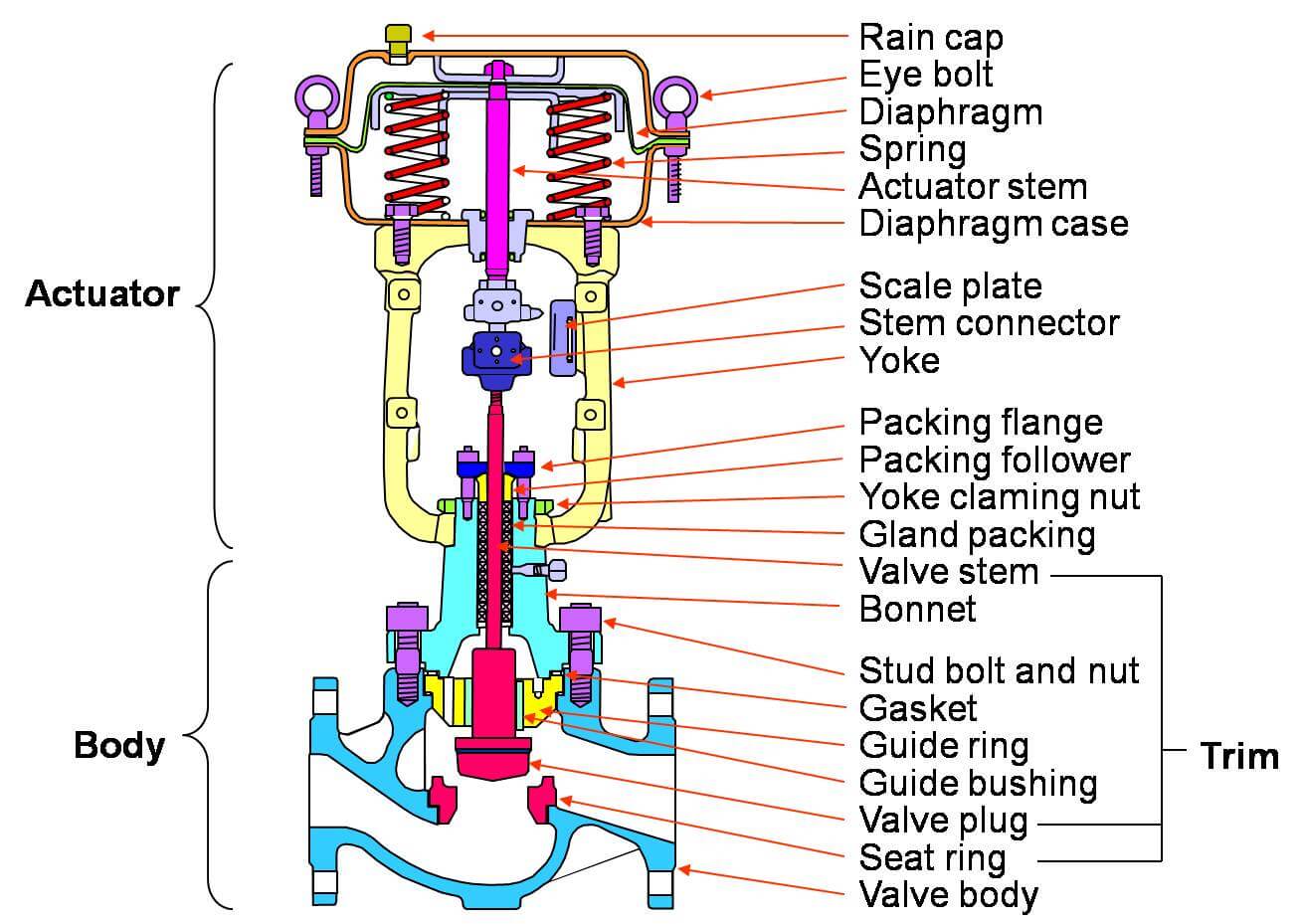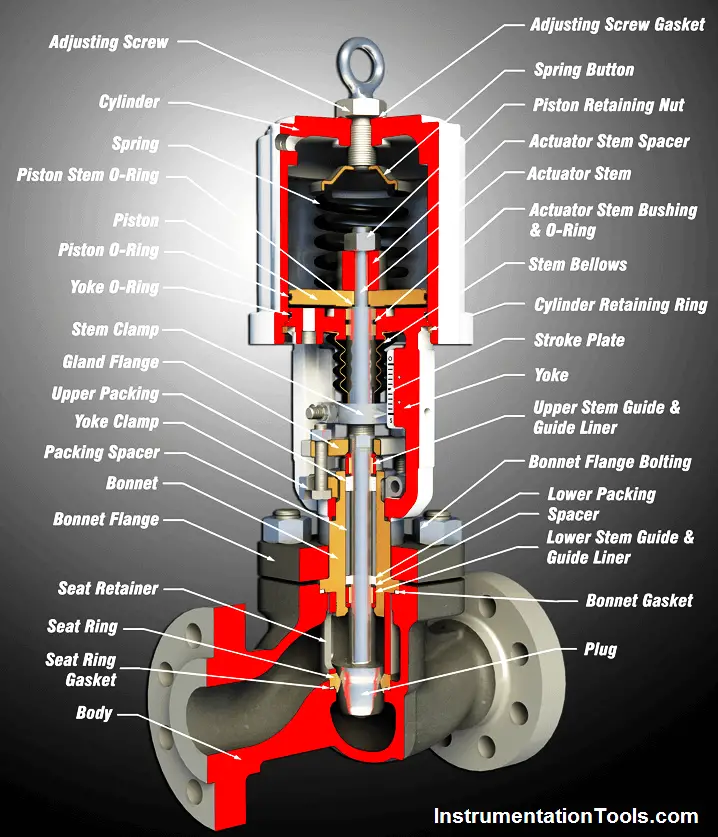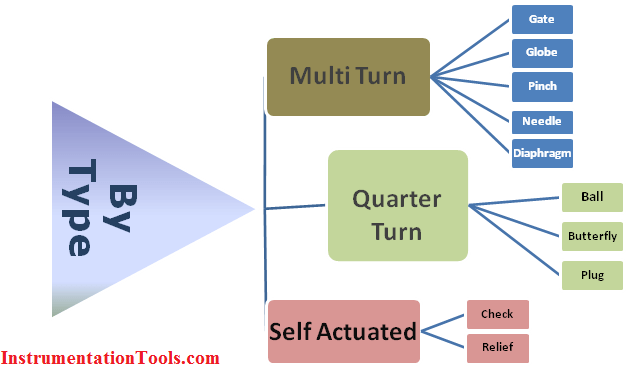A valve is a mechanical device that controls the flow of fluid and pressure within a system or process. A valve controls system or process fluid flow and pressure by performing any of the Following functions.
a) Stopping and starting fluid flow
b) Varying (throttling) the amount of fluid flow
c) Controlling the direction of fluid flow
d) Regulating downstream system or process pressure
e) Relieving component or piping over pressure
There are many valve designs and types that satisfy one or more of the functions identified above. A multitude of valve types and designs safely accommodate a wide variety of industrial applications.
Basic Parts of Control Valves
Regardless of type, all valves have the following basic parts: the body, bonnet, trim (internal elements), actuator, and packing. The basic parts of a valve are illustrated in Figure 1.
Control Valves mainly have Two parts:
1) Actuator Part
2) Body Part for easy understanding.

1. Actuator Part
For valve control, it will be classified as either a Phenumatic, Motorized and Hydrolics but is commonly used in our industry, it is Phenumatic Actuator Actuator or controlled by the wind itself. For easy maintenance Actuator simple structure which will include the Yoke, too.
Various components of the Actuator
- Rain Cap I pray for them not to let water flow into the Actuator for Action of the Air to Open Actuator is that the wind will be from the bottom of the Actuator so the holes are left blank. Find something else to disabled To keep water when it rains. And must be taken off the air valve at the back.
- Eye Bolt for use on the hook. Moving the valve
- Diaphragm is flexible. To change the incoming wind power and power passed to Diaphragm plate to make Actuator Stem Cell.
- Spring is in the Yoke Actuator Case or, depending on the design of the manufacturer. It will act as a force for Actuator Stem Cell and a strong wind from the opposite direction to the plate Diaphragm.
- Actuator Stem is interconnected with Actuator Valve Stem.
- Diaphragm Case are the parts that are used for packing Diaphragm plate consists of two parts: the upper and lower sections.
- Scale Plate is based on the position of the valve between 0-100%.
- Stem Connector is the link between them for Actuator Stem and Plug Stem.
- Yoke is a component that is used for connecting sections of the Actuator and Valve Body.
2. Body Part
Part of Body Valve is included in the Bonnet valve with which this segment is exposed to the fluid (fluid) directly, so choosing the required qualifications material (material) as well as Fluid type, Temp, Pressure and. etc
- Packing Flange is used for compression of the stud bolt to make the most of all the Gland Packing tight and fluid can not leak out of the neck Bonnet.
- Packing Follwer is the strength of Packing Flange Gland Pakcing tightly compressed to tighten over time.
- Yoke Claim Nut
- Gland Packing is important that we prevent the leakage of fluid up to the neck and is in direct contact with Bonnet Plug Stem The choice of material and type to fit so there is a huge need.Most of the material used is PTFE or Graphite and maintenance each time. The need to change the Gland Packing all times.
- Valve Stem is the strength of the Actuator and connected to Plug.
- Bonnet was primarily used for supporting the position of the Plug-time scroll up, scroll down to find it. No left and right But some manufacturers cut output to reduce the Bonnet Cost for the production and sale of the valve. The maintenance is also difficult. It is not to come and support the position of the Plug and Seat to meet constantly Lapping.
- Stud Bolt and Nut
- Gasket is a device used to prevent leaks during the assembly of iron and steel as well as between the Body and Bonnet.
- Guide Ring is located in Bonnet order to align Plug straight up. Another reason for having Guide Ring Bonnet, instead of doing all the reason to reduce maintenance time Cost. Because this section is always exposed to Stem Plug sometimes wear if not Guide Ring may be a whole instead of only replacing Bonnet Guide Ring.
- Guide Bushing is used for supporting Guid Ring again.
- Valve Plug is essential to use the force of fluid flow. And determine the flow properties as Linear, Equal Percentage or Quick Openning.
- Seat Ring is a component that is part of Valve Body and given the size of the Rated Cv of the valve and which supports Plug and Plug and Seat Ring must be close together. To be able to follow the Class Leakage as needed.
- Valve Body , a major component of the round and get direct contact with the fluid. The connection to the pipeline Therefore, the size and material must be chosen accordingly. Read more at PT Rating by Valve Body structure is a frequently encountered 1. Single-Ported is a 1 plug with 1 seat 2. Double-Ported is a 2 plug with 2 Port 3. Two-Way Valve is. There will be two connections (one inbound and one outbound) 4. Three-Way Valve is to have three connections (one or two inbound and two outbound, inbound and one outbound).
Trim Set the control valve (Trim Control Valve) is the word of Plug Stem Seat Ring, which collectively set trim (trim set) itself.
Positioner or position will be the key to control of the control valve. The industry standard device that converts the signal (signal standard), such as 4-20 mA, 3-15 psi as wind power to propel Actuator head movements.

Explain in detail about main valve parts ?
Valve Body
The body, sometimes called the shell, is the primary pressure boundary of a valve. It serves as the principal element of a valve assembly because it is the framework that holds everything together.
The body, the first pressure boundary of a valve, resists fluid pressure loads from connecting piping. It receives inlet and outlet piping through threaded, bolted, or welded joints.
Valve bodies are cast or forged into a variety of shapes. Although a sphere or a cylinder would theoretically be the most economical shape to resist fluid pressure when a valve is open, there are many other considerations.
For example, many valves require a partition across the valve body to support the seat opening, which is the throttling orifice. With the valve closed, loading on the body is difficult to determine. The valve end connections also distort loads on a simple sphere and more complicated shapes.
Ease of manufacture, assembly, and costs are additional important considerations. Hence, the basic form of a valve body typically is not spherical, but ranges from simple block shapes to highly complex shapes in which the bonnet, a removable piece to make assembly possible, forms part of the pressure-resisting body.
Narrowing of the fluid passage (venturi effect) is also a common method for reducing the overall size and cost of a valve. In other instances, large ends are added to the valve for connection into a larger line.
Valve Bonnet
The cover for the opening in the valve body is the bonnet. In some designs, the body itself is split into two sections that bolt together. Like valve bodies, bonnets vary in design. Some bonnets function simply as valve covers, while others support valve internals and accessories such as the stem, disk, and actuator.
The bonnet is the second principal pressure boundary of a valve. It is cast or forged of the same material as the body and is connected to the body by a threaded, bolted, or welded joint. In all cases, the attachment of the bonnet to the body is considered a pressure boundary. This means that the weld joint or bolts that connect the bonnet to the body are pressure-retaining parts.
Valve bonnets, although a necessity for most valves, represent a cause for concern. Bonnets can Complicate the manufacture of valves, increase valve size, and represent a significant cost portion of valve cost, and are a source for potential leakage.
Valve Trim
The internal elements of a valve are collectively referred to as a valve’s trim. The trim typically includes a disk, seat, stem, and sleeves needed to guide the stem. A valve’s performance is determined by the disk and seat interface and the relation of the disk position to the seat.
Because of the trim, basic motions and flow control are possible. In rotational motion trim designs, the disk slides closely past the seat to produce a change in flow opening. In linear motion trim designs, the disk lifts perpendicularly away from the seat so that an annular orifice appears.
Disk and Seat
For a valve having a bonnet, the disk is the third primary principal pressure boundary. The disk provides the capability for permitting and prohibiting fluid flow. With the disk closed, full system pressure is applied across the disk if the outlet side is depressurized.
For this reason, the disk is a pressure-retaining part. Disks are typically forged and, in some designs, hard-surfaced to provide good wear characteristics. A fine surface finish of the seating area of a disk is necessary for good sealing when the valve is closed. Most valves are named, in part, according to the design of their disks.
The seat or seal rings provide the seating surface for the disk. In some designs, the body is machined to serve as the seating surface and seal rings are not used. In other designs, forged seal rings are threaded or welded to the body to provide the seating surface.
To improve the wear-resistance of the seal rings, the surface is often hard-faced by welding and then machining the contact surface of the seal ring. A fine surface finish of the Seating area is necessary for good sealing when the valve is closed. Seal rings are not usually considered pressure boundary parts because the body has sufficient wall thickness to withstand design pressure without relying upon the thickness of the seal rings.
Stem
The stem, which connects the actuator and disk, is responsible for positioning the disk. Stems are typically forged and connected to the disk by threaded or welded joints. For valve designs requiring stem packing or sealing to prevent leakage, a fine surface finish of the stem in the area of the seal is necessary. Typically, a stem is not considered a pressure boundary part.
Connection of the disk to the stem can allow some rocking or rotation to ease the positioning of the disk on the seat. Alternately, the stem may be flexible enough to let the disk position itself against the seat. However, constant fluttering or rotation of a flexible or loosely connected disk can destroy the disk or its connection to the stem.
Two types of valve stems are rising stems and non-rising stems. These two types of stems are easily distinguished by observation. For a rising stem valve, the stem will rise above the actuator as the valve is opened. This occurs because the stem is threaded and mated with the bushing threads of a yoke that is an integral part of, or is mounted to, the bonnet.
There is no upward stem movement from outside the valve for a non rising stem design. For the non rising stem design, the valve disk is threaded internally and mates with the stem threads.
Valve Actuator
The actuator operates the stem and disk assembly. An actuator may be a manually operated hand wheel, manual lever, motor operator, solenoid operator, pneumatic operator, or hydraulic ram. In some designs, the actuator is supported by the bonnet. In other designs, a yoke mounted to the bonnet supports the actuator.
Except for certain hydraulically controlled valves, actuators are outside of the pressure boundary.Yokes, when used, are always outside of the pressure boundary.
Valve Packing
Most valves use some form of packing to prevent leakage from the space between the stem and the bonnet. Packing is commonly a fibrous material (such as flax) or another compound (such as teflon) that forms a seal between the internal parts of a valve and the outside where the stem extends through the body.
Valve packing must be properly compressed to prevent fluid loss and damage to the valve’s stem. If a valve’s packing is too loose, the valve will leak, which is a safety hazard. If the packing is too tight, it will impair the movement and possibly damage the stem.
Introduction to the Types of Valves
Because of the diversity of the types of systems, fluids, and environments in which valves must operate, a vast array of valve types have been developed. Examples of the common types are the globe valve, gate valve, ball valve, plug valve, butterfly valve, diaphragm valve, check valve, pinch valve, and safety valve. Each type of valve has been designed to meet specific needs.
Some valves are capable of throttling flow, other valve types can only stop flow, others work well in corrosive systems, and others handle high pressure fluids. Each valve type has certain inherent advantages and disadvantages. Understanding these differences and how they effect the Valve’s application or operation is necessary for the successful operation of a facility.
Although all valves have the same basic components and function to control flow in some fashion, the method of controlling the flow can vary dramatically. In general, there are four methods of controlling flow through a valve.
- Move a disc, or plug into or against an orifice (for example, globe or needle type valve).
- Slide a flat, cylindrical, or spherical surface across an orifice (for example, gate and plug valves).
- Rotate a disc or ellipse about a shaft extending across the diameter of an orifice (for example, a butterfly or ball valve).
- Move a flexible material into the flow passage (for example, diaphragm and pinch valves).
Each method of controlling flow has a characteristic that makes it the best choice for a given application of function.
Types of valves

Gate valves are generally used in systems where low flow resistance for a fully open valve is desired and there is no need to throttle the flow.
Globe valves are used in systems where good throttling characteristics and low seat leakage are desired and a relatively high head loss in an open valve is acceptable.
Ball valves allow quick, quarter turn on-off operation and have poor throttling characteristics.
Plug valves are often used to direct flow between several different ports through use of a single valve.
Diaphragm valves and pinch valves are used in systems where it is desirable for the entire operating mechanism to be completely isolated from the fluid.
Butterfly valves provide significant advantages over other valve designs in weight,space, and cost for large valve applications.
Check valves automatically open to allow flow in one direction and seat to prevent flow in the reverse direction.
A stop check valve is a combination of a lift check valve and a globe valve and incorporates the characteristics of both
Safety/relief valves are used to provide automatic over pressurization protection for a system.
very nice article sir,, thanks
very nice article indeed, thank you and keeo up the good work
Very interesting sir. I have been looking out for article like this. Is there any training going on for instrumentation? .So, one can enrol. Thanks!
Thanks so much sir
very nice article sir,, thanks
very nice article thanks
Thank you very much for this!! Really appreciate it!!
I need to learn in ocean instrumentation
Looks so simple and nice
Useful information. Thank you.
easy to learn from scratch to beginner thankss